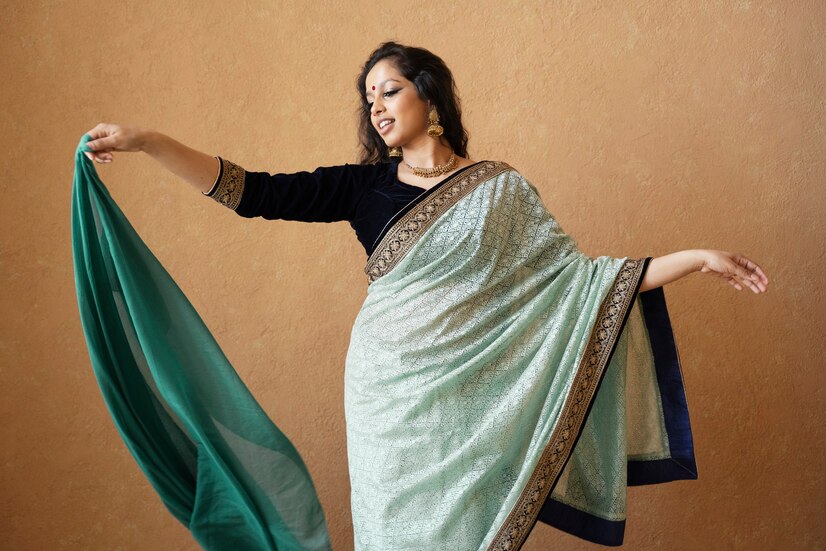Page Contents
A Variety of Saree Draping Styles Across Indian Attire
There are numerous saree draping styles, each with its own unique charm and cultural significance. Here are descriptions of some popular saree draping styles:
Nivi Style: The Nivi style is the traditional saree draping style from Andhra Pradesh. It involves pleating the saree neatly and draping it over the left shoulder, allowing the pallu to fall gracefully.
Gujarati Style: In the Gujarati style, the pallu is draped in the front from the right side to the left shoulder and then brought back to the right shoulder. It is often paired with a backless choli (blouse) and looks elegant.
Bengali Style: The Bengali saree draping style is characterized by multiple pleats in the front, with the pallu elegantly draped over the left shoulder and hanging down the back. It’s commonly worn during traditional Bengali occasions.
Maharashtrian Nauvari Style: This style is from Maharashtra and involves draping the saree in a way that resembles a nine-yard dhoti. It is known for its unique look, with the pallu brought forward from the back and then tucked into the waist.
Tamilian Style: In the Tamilian saree draping style, the saree is often draped without pleats, giving it a casual, free-flowing look. The pallu is typically pinned over the left shoulder.

Kodagu Style: This style hails from Kodagu in Karnataka. The saree is draped in a unique way, with the pallu pulled from behind the right shoulder to the front and then pinned.
Mumtaz Style: Inspired by the legendary actress Mumtaz, this style involves draping the saree in a way that creates a high, front-facing pleat. It’s often paired with a tight, body-hugging blouse.
Butterfly Style: In the Butterfly style, the pallu is pleated and pinned over the left shoulder, resembling the wings of a butterfly. It’s popular for its elegant and eye-catching look.
Lehenga Style: As mentioned earlier, the Lehenga Style saree draping involves wearing the saree like a lehenga skirt with pleats in the front and the pallu draped over the shoulder.
Rajrani Style: This style is reminiscent of the royal attire of Rajasthan. The saree is draped with a single, large pleat at the front and the pallu brought over the right shoulder and across the chest.
These are just a few examples of the diverse ways in which sarees can be draped in different regions of India, each reflecting the culture, tradition, and personal style of the wearer.
FAQs on Diverse Saree Draping Techniques in Indian Couture
How many traditional saree draping styles are there in Indian fashion?
A: Indian fashion boasts numerous styles, each representing regional cultures with distinct draping techniques.
Q: Can I experiment with modern twists in saree draping?
A: Absolutely! Contemporary designers often infuse creativity, allowing for innovative and personalized interpretations of traditional styles.
Q: Are saree draping styles influenced by occasions or events?
A: Yes, the choice of draping style often reflects the formality of the occasion, with some styles reserved for weddings, festivals, or casual wear.
Q: Are there specific draping styles for different regions in India?
A: Yes, each state in India has its own unique saree draping style, contributing to the rich diversity of Indian fashion.
Q: Can saree draping styles be adapted for various body types?
A: Absolutely! Skilled draping can enhance different body shapes, offering flattering and comfortable options for everyone.
Q: What accessories complement specific saree draping styles?
A: Accessories like bangles, bindis, and statement jewelry vary based on the draping style, adding a finishing touch to the overall look.
Q: How can one learn to drape sarees in different styles?
A: Many online tutorials, workshops, and fashion classes offer step-by-step guidance, making it accessible for enthusiasts to master various saree draping techniques.
In conclusion, the saree draping styles in Indian fashion encapsulate a rich tapestry of tradition, diversity, and creativity. These styles not only reflect regional cultures but also offer a canvas for personal expression and innovation. From traditional elegance to contemporary twists, saree draping serves as a dynamic and evolving aspect of Indian fashion, contributing to its timeless charm and global allure. Embracing these styles allows individuals to not only celebrate cultural heritage but also express their unique fashion sensibilities, creating a harmonious blend of tradition and modernity.
Explore Further: Also Read these Engaging Articles
Kiwi Power: Unlocking the Nutritional Benefits of Kiwi Juice



